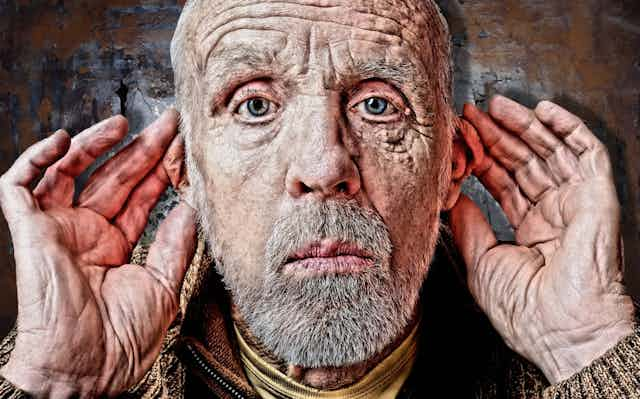This article is part of our series on older people’s health. It looks at the changes and processes that occur in our body as we age, the conditions we’re more likely to suffer from and what we can do to prevent them.
As the baby boomer generation begins to age, the prevalence of both eye and ear disease will rise exponentially, as there is a strong correlation between vision loss, hearing loss and ageing.
The World Health Organisation estimates that 285 million people worldwide are visually impaired, with 82% of people with blindness aged 50 and above. Australia alone will have 800,000 people aged 40 or over with low vision or hearing loss by 2020.
As people age, they often experience a number of changes in their physical, mental and social health. Among these are eye and ear changes, and diseases that usually result in vision and hearing loss. Changes to our eyes and ears occur as a result of disease, genetic factors, “wear and tear” and environmental factors.
What happens in our eyes as we age?
There are a range of changes in our eyes that occur as a result of age. For example, over time the whites of the eyes, or “sclera”, undergo changes due to exposure to ultraviolet light.
These changes include a yellowing or browning of the white of the eye due to fatty or cholesterol deposits in the conjunctiva – the mucous membrane that covers the eye – also related to ageing and exposure to ultraviolet light.
Over time, changes also occur in the conjunctiva, such as a thinning of the membrane. This often results in dry eye, a condition caused mainly by reduced production of tears and reduced mucous from the conjunctiva.
As we age, we often experience a decrease in the strength of our muscles. This is no different in the eye, and the muscles in our eyelids can become weaker over time. Reduced tone in the muscle that gives shape to our lens, as well as stiffening of the natural lens with age, causes presbyopia (inability to see near objects), necessitating the use of reading glasses.
Eye disorders that commonly occur in older adults include:
macular degeneration. This terms describes damage to the pigmented oval in the centre of the retina resulting in decreased central vision and seeing fine detail. This happens as we age because of deposits of fine grains that build up in the retina.
Cataracts. This is a clouding of the lens that covers the eye. These are thought to be caused by breakdown and degradation of lens proteins, and are considered a part of the normal ageing of the lens.
Diabetic retinopathy. This is damage to the retina resulting from diabetes. Type 2 diabetes is age related and the duration and control of blood glucose levels often determine whether or not diabetic retinopathy does or does not develop.
Glaucoma. When glaucoma occurs, the optic nerve is progressively damaged resulting in loss of the peripheral visual field.
Among older Australians, cataract is the most common eye disease and cause of visual impairment (over 70% of people in Australia aged 80 years and over have cataracts), followed by age-related macular degeneration (occurring in 3.1% of older people).
What happens in our ears as we age?
As we get older, we experience changes all over our body, including the ears. Commonly, people’s ears (outer ears, that is) become bigger, earwax accumulates more easily and there is more cartilage in the external ear canal.
There is also often a stiffening of the eardrum and changes to the neural (nerve) system.
These changes contribute to older people suffering from hearing loss and central auditory processing disorders, in which the ear cannot properly process sounds.
How these changes affect daily life
As a result of these numerous eye and ear changes and diseases, older people typically have vision and hearing problems that include sensitivity to light and difficulty visualising distant objects or reading print.
Hearing problems include difficulty with perceiving and discriminating sounds (including speech), understanding speech (particularly in poor listening situations such as when there is high background noise or echo), and processing auditory information.
These difficulties interfere with older adults’ everyday functioning and participation in activities. People with sensory loss may have difficulty performing independent activities of daily living such as bathing and shopping. This means they’re more at risk of problems with mental health and social interaction.
One of the most disabling effects of vision and hearing loss is decreased ability to communicate with others. People with severe vision loss (low vision or legal blindness) have difficulty lip reading or perceiving non-verbal cues (such as facial expression or gestures).
Those with hearing loss have communication difficulties including difficulty perceiving sounds or following a conversation. For people with loss of both senses, communication difficulties are much worse. They can’t adequately receive a verbal message and frequently misunderstand conversation.
Management of sensory loss
Management of sensory loss requires assessment by professionals (such as optometrists and audiologists) who will recommend the appropriate management plan that may include the use of a visual or hearing device.
Speech pathologists also play a role, with programs including speech perception training or communication programs for clients and carers.
Early identification and intervention can help those with vision and hearing loss so the effects of these sensory losses can be minimised, improving their quality of life.
Acknowledgement: Dr Julian Sack (Ophthalmologist) for his input. Read other articles in the series here.

